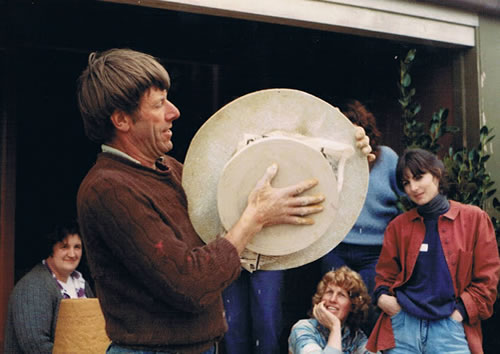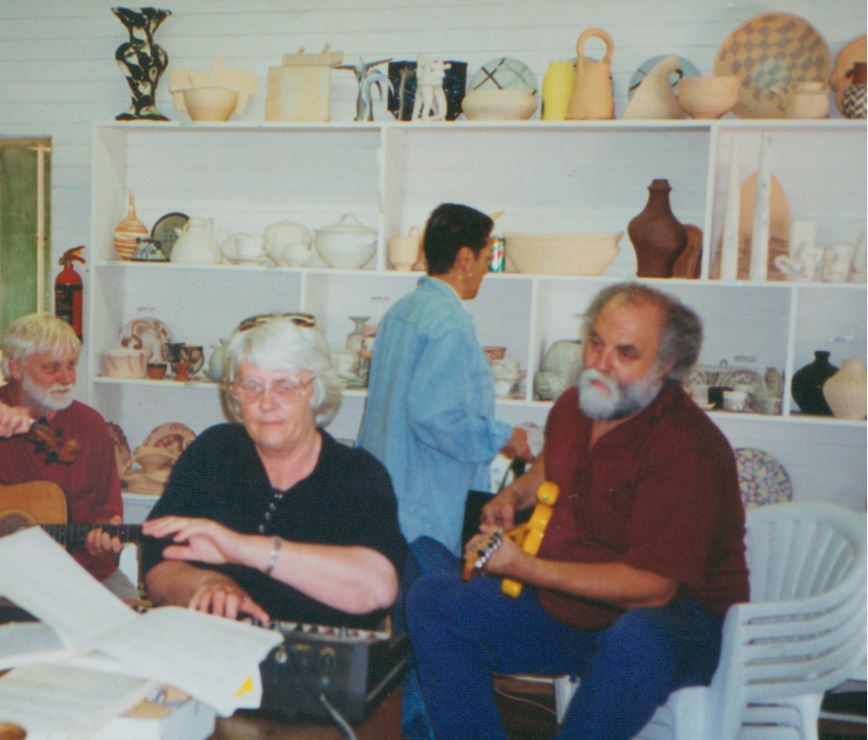The History of the Auckland Studio Potters Society
Background
The Auckland Studio Potters Association (ASP) has promoted and supported potters in Auckland for over 60 years. That kind of loyalty has enabled the ASP to flourish, to enhance recognition for the pottery and ceramic arts in Auckland and New Zealand.
In 1961 the ASP was initially set up by an amalgamation of most of the smaller pottery societies around Auckland. Over the years the organisation grew as the popularity of pottery grew. The ASP has held over 40 selected exhibitions, was responsible for running the internationally prestigious Fletcher Challenge Ceramics Award (originally the Fletcher Brownbuilt) for 21 years, and has also run a number of open exhibitions, all with the aim of introducing the public to pottery and ceramics. Its mission statement requires pottery exhibition and education for Aucklanders, and that is what it does.
The ASP was responsible for setting up the current premises, moving the old house onto a vacant piece of council land in 1975. The kiln shed was built soon after and housed a brick diesel kiln. Designed by architect Roger Paul, one of the early members, it featured walls that could be opened completely so that the clouds of smoke could be blown away and the firers kept alive. The large teaching studio was built in 1994 as a purpose-built facility for both the members and students. It was equipped with 19 wheels, a pug mill and a glazing area. There are now 12 kilns on the site including a small gas raku, various wood, diesel, salt fired brick kilns, 7 electric kilns, 1 very busy gas fibre kiln. It positions the ASP as the premium pottery institution in Auckland, for teaching, support and exhibitions.
Origins
Officially the Auckland Studio Potters Association came into being in March 1961 but prior to that, as early as 1925 the stage was being set for the growth and beginnings of the studio pottery movement in Auckland. Briar Gardner had watched pipes being extruded and flanges expertly turned at the family's Amalgamated Brick and Pipe Co. and so began a long association with the lovely plastic stuff. Wheels were installed in the brickyards and Briar soon built up a collection of pots and bisqued them in the brick kiln. Made of coarse pipe clay they were decorated with barbola, paint and gold lacquer and were to be the basis for her first show in 1925.
None of the technical data so readily available now was at hand to assist Briar and another forerunner, Olive Jones, in their search for that elusive effect towards which they were constantly striving. Olive had been a student in London at the Central School of Arts and Crafts at the same time as another New Zealander, Robert Field and in 1934 they both returned to NZ, Robert to a teaching position in Dunedin and Olive to set up her own pottery in Auckland. Her first backyard kiln used an oil burner in a 300-gallon iron tank. Starlings built nests of wet straw in the chimney - opossums moved in too - just some of the teething problems encountered.
With the war years, the shortage of imports led to increased demand for locally made goods. Olive built a larger kiln and Briar left the brickyards and built an oil-fired kiln in her own backyard. Both continued to hold exhibitions throughout the forties. Yugoslav Jova Rancich, who had arrived to first work on the gum-fields and then as a stonemason, was driven during the depression to revive potting skills learned as a youth in his native Serbia. He tried to interest Briar Gardner in partnering him in the workshop/pottery he started in Titirangi Road. He made coffee mugs when New Zealanders thought it peculiar not to drink tea. The assured forms of his brightly glazed pots were an attraction to passing motorists and played some part in fostering the growing public interest in studio pottery.
Avondale College Days
At the conclusion of the war the American Services Hospital became Avondale College and training of workers for the nearby Crown Lynn works was undertaken. Soon the Education Department was prevailed upon to start night classes in pottery and Robert Field came from Dunedin to take charge of this programme. This was in 1945 and many studio potters began their clay involvement there.
Pat Perrin, after wartime service in the Wrens, attended sculpture classes at Elam and on the advice of the late Murray McNair joined the pottery class under Field's tuition thereby starting a long association with pottery. She was the first tutor at the Adult Education classes and for many years taught night classes at Avondale College, and also taught at the ASP for many years. Just a few more names recalled from those Avondale days are Paula King, Len Castle, Betty Brookes, Peter Stichbury, Nancy and Martin Beck, Mavis Robinson, Ron Hall and Melva Firth.
Len Castle went onto the Training College staff and had his early pots salt glazed in the brickwork kilns. He was awarded the Fellowship of the Association of N.Z. Arts Societies for overseas study and spent 1956-7 working in the Bernard Leach Potteries in St Ives, Cornwall. Peter Stichbury also received this Fellowship in 1958 and used it for study, both with Leach and with Michael Cardew in Nigeria. He was on the staff at Ardmore Teachers' College for many years on his return to New Zealand.
The Becks had their kiln and studio at Takapuna and exhibited widely. The late Martin became the first ASP President in 1961. Small groups around Auckland sprang up around this time; meeting to exchange ideas and technique advances with larger groups meeting in Summer Schools at the Adult Education Centre in Symonds Street. The Auckland Society of Arts used to have an annual exhibition at the Auckland Art Gallery in which pottery made by the exhibiting members was included. Briar Gardner, Olive Jones, Len Castle and Pat Perrin were represented in these exhibitions, which continued until the formation of Auckland Studio Potters when many of these smaller groups amalgamated.
2023
There has been a resurgence of pottery making over the past few years, which has seen the ASP’s membership grow to about 300 people. These days the centre is managed by one director and one assistant, with 8 regular daytime and evening classes with consistent tutors. Added into this mix are frequent workshops with guest tutors that will either continue for a whole term or are held on weekends. Potters like Andrew Van der Putten, Chris Southern, Jo-Anne Raill, Pauline McCoy, Jenny Lange and Richard Naylor are long-serving tutors. Margaret Sumich, Peter Lange, Renton Murray and many more potters have helped to make the ASP what it is today. The members gather frequently for exhibition openings, artist talks, and specialised firings are held from time to time – salt, wood, soda and gas.
The Diploma in Ceramic Arts course, based at the Otago Polytechnic School of Art, has added an extra layer to the structure and provides up to 15 students each year with much more intensive workshop tuition, supplemented by theory and design papers provided online by Otago. This course has improved the quality of the work coming out of the ASP kilns, and that in turn is absorbed by the rest of the people using the facility.
The ASP is in a very strong and positive state these days.


